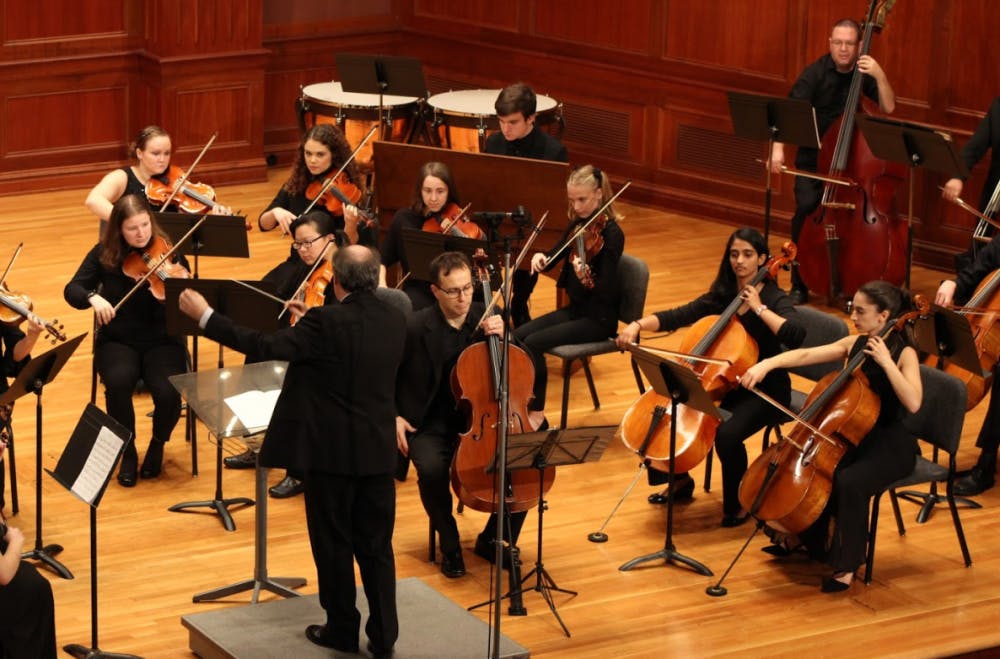By Julia Duggan
Staff Writer

Mayo Concert Hall was packed as the TCNJ Orchestra performed its fall concert on Friday, Nov. 1.
The orchestra’s director and violin professor Uli Speth conducted the concert, where the orchestra performed Symphony No 5 in D minor Op. 107 “Reformation” by Felix Mendelssohn and “Concerto for Violincello and String Orchestra” by Georg Mathias Monn, featuring cello professor Alberto Parrini.
The concert opened with the latter song, where Parrini played with a beautiful tone and elegant sound that resonated throughout the hall.
The orchestra, which blended well with Parrini, also featured a harpsichord in the first piece. As an ancestor to the piano, the instrument added an unusual, but pleasant sound to the song. The audience responded with a loud applause, which lasted so long that Parrini had to return to the stage to take another bow.
“Parrini had some very impressive cello parts,” said Nick Marsola, a sophomore music major. “It was an honor to have played with him.”
After the first piece, Speth went on stage and explained origin behind Symphony No 5 in D minor, Op. 107 “Reformation.”
Roughly 500 years, ago the German States came together to accept Protestantism after the ongoing dispute with Catholicism. Peace was made and Martin Luther wrote a chorale to celebrate.
Johann Sebastian Bach later took the chorale and turned it into an instrumental piece. Felix Mendelssohn took Bach’s piece and turned it into a four-movement symphony. In the first movement, the brass section has the melody from the original chorale.
The orchestra came back out to perform the symphony with an additional 16 members, as Mendelssohn had added a few unusual instruments to his piece. In the fourth movement, he added a contrabassoon.
While the instrument looks very similar to the bassoon, it is a bit larger and has a very low range that can match a tuba. There was also an alto and bass trombone. While both instruments are similar, the bass trombone has a lower range similar to the contrabassoon.
The alto trombone looks like a smaller version of a normal one, as it is about half the size and it can match the range of a trumpet.
In the first movement, the orchestra was exceptionally quiet and grand. As the second movement began, the audience got to hear a bit more of the orchestra’s power.
“It just turned out so amazing,” said Geovanni Delgado, a sophomore elementary education major. “Combining the string instruments with the woodwinds and brass it is such a hard thing to do and make it sound good. It was very well put together.”
The bows of the violins and violas moved at an impressively quick pace. In the third movement, the orchestra managed to get even quieter than before. But it was the fourth movement that showcased the orchestra’s greatest volume and height.
“The entire orchestra has put in incalculably hard work on (the fourth movement) in particular, and the music itself is jubilant and outright joyful,” said Mark O’Malley, a sophomore chemistry major who performed. “Plus, I get to break out the contrabassoon, which in it of itself makes my day. To my ears, having that additional bass sound really helps round out the instrumentation, and generally makes the group sound bigger and more impactful, which can help us in performance.”
As the orchestra finished its final grand piece, audience members returned the favor with thunderous applause, as they found the mixture of instruments to be enjoyable.
“I am a brass player, so I do not get to hear strings too often, but I’ve got to say, this concert was amazing,” said David Cohn, a sophomore psychology major.







